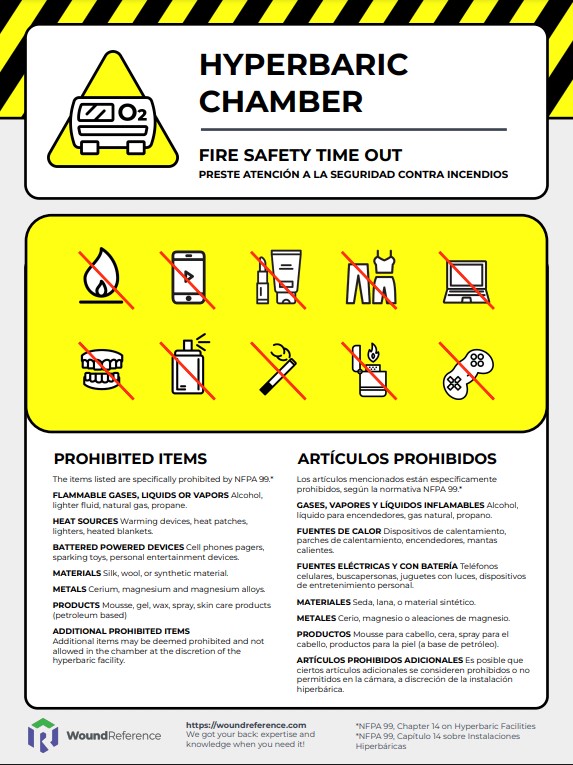Last updated on 6/19/24 | First published on 11/30/18 | Literature review current through Aug. 2025
[cite]
Authors:
Jeff Mize RRT, CHT, UHMSADS,
Tiffany Hamm BSN, RN, CWS, ACHRN, UHMSADS,
more...
Coauthor(s)
Jeff Mize, RRT, CHT, UHMSADS
Disclosures: Nothing to disclose
Tiffany Hamm, BSN, RN, CWS, ACHRN, UHMSADS
Chief Nursing Officer, Wound Reference, IncDisclosures: Nothing to disclose
Editors
Safety Stop
Clinicians providing hyperbaric oxygen therapy go to great lengths to ensure patient safety with every treatment. We utilize processes and systems that have been developed within the field, in some cases through “near misses” and from standards set forth by The Joint Commission (TJC) and the Undersea and Hyperbaric Medical Society (UHMS). [1][2]
In June of 2014, the UHMS Safety Committee released a position statement recommending the utilization of a safety “Stop” prior to the start of every hyperbaric treatment.[2] The position statement is available on the UHMS website:
“The Safety Committee of the Undersea and Hyperbaric Medical Society recommends that a Safety Time Out/Pause (STOP) be performed prior to the start of every hyperbaric treatment. A STOP should be completed regardless of multiplace or monoplace operations. A STOP will be performed in order to be compliant with safety goals, to combat complacency, and document completion of our unique safety practices. We recommend that the STOP be modeled after the timeouts performed before surgical procedures."
STOP Checklist
The Practice of Hyperbaric medicine is a procedure-oriented specialty. Each patient should have two identifiers verified and the patient should agree to the procedure. For the safety of patients and staff, we strongly encourage documentation of a Safety Time Out/Pause (STOP) protocol verifying the “Right Patient, Right Treatment and Right Safety.” [2] The STOP checklist should include:
- Signature and date on the completed STOP checklist (signed or initialed by two staff members prior to closing the door of the chamber)
- Treatment profile and staffing plan
- Out of the chamber - confirmation that prohibited items were removed from the chamber (both monoplace and multiplace)
- Patient ground check (monoplace)
The UHMS recommends that each hyperbaric facility and institution develop and implement a STOP protocol with these basic elements [2]:
- Refer to this 'Safety Time Out/Pause (STOP) checklist' basic template, which can be adapted to fit your needs. Prior to use, ensure the adapted version is reviewed and approved by responsible parties within the HBO clinic/hospital. A more detailed protocol may be in order depending on the specific needs of the facility.
- Refer to the poster "Fire Safety Time Out", which can be used to remind patients of items that are specifically prohibited by NFPA 99.

The UHMS Safety Committee position statement provides a structured approach to pre-treatment procedures. This statement is long overdue and should be taken one step further to include pre-hyperbaric treatment checklists. Pre-treatment checklists have been employed for many years and include inspection and confirmation that Prohibited Items have been removed from the patient’s possession prior to initiation of the treatment. Elements of the Safety STOP should be included in all pre-treatment checklists.
In an article published on the NEJM Catalyst website, “Smartlists for Patients: The Next Frontier for Engagement?” Latif et al. identify that checklists work by providing information about who needs to act, what actions need to be taken, and how, where, and when each action should occur.[3] As such, customized patient-centered checklists have a wide range of applications, with the potential to improve patient education, pre-procedure planning, discharge instructions, care coordination, chronic care management, and plans for staying well.
The question becomes, at what point is the inspection and verification of Prohibited Items documented? Are you inspecting the patient, verifying, initiating treatment (descent) and then documenting? If so, then utilizing a “STOP” prior to the initiation of descent should be implemented and utilized to ensure all pre-treatment safety checks are appropriately completed.
Official reprint from WoundReference® woundreference.com ©2025 Wound Reference, Inc. All Rights Reserved
Use of WoundReference is subject to the
Subscription and License Agreement.
NOTE: This is a controlled document. This document is not a substitute for proper training, experience, and exercising of professional judgment. While every effort has been made to ensure the accuracy of the contents, neither the authors nor the Wound Reference, Inc. give any guarantee as to the accuracy of the information contained in them nor accept any liability, with respect to loss, damage, injury or expense arising from any such errors or omissions in the contents of the work.